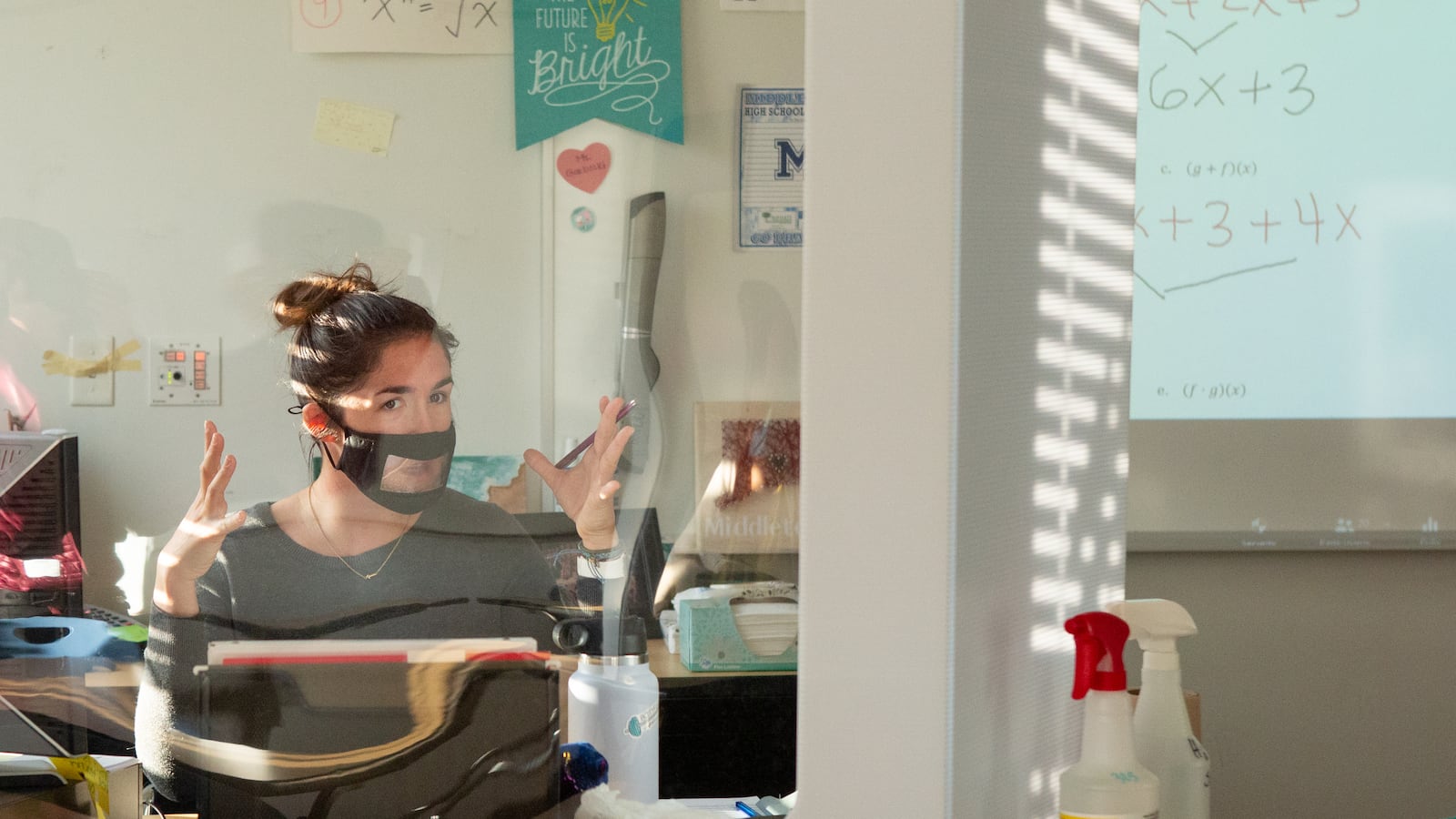They wore microphones and tried face shields. They cut holes into surgical masks for instruments. They leaned more heavily than normal on videos and other visuals. And they spent a lot of their days telling students over and over to pull their masks up.
“I can see your face — it’s gorgeous — but I don’t want to,” one teacher repeatedly joked with her high schoolers.
For educators who worked with students in person this last year, masks changed their jobs in many ways. Chalkbeat asked educators to share how masks impacted their lives this school year and spoke to several around the country about their experiences. They each said they supported wearing masks — and kept theirs on the whole year, whether it was required or not.
But face coverings presented challenges. Mask mandates were hard to enforce with students. Talking clearly all day and breathing were difficult. And teaching social and emotional learning with half their faces covered was tricky.
Despite the challenges, these teachers found creative ways to connect with their students anyway. Next year, they hope, it will be safe enough to go back to normal.
Heather Meier
St. Vrain Valley School District in Longmont, Colorado
Teaches band to students in 6th to 8th grades
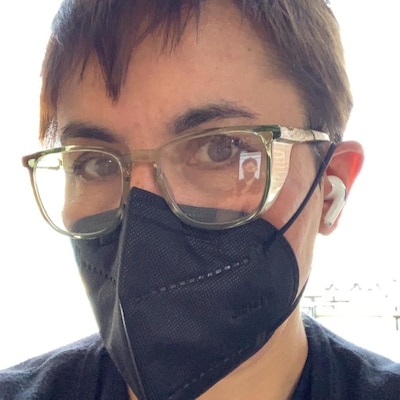
Band practice in Heather Meier’s middle school class looked quite a bit different this last year than it did in the past. First of all, she estimates that the class of sixth graders was about half the size it usually is. “There might have been some parents who were like, ‘no, that doesn’t seem like a good idea this year,’” Meier said.
Students and staff in the St. Vrain Valley School District in Firestone, Colorado, had to wear masks at all times while at school — including when they were playing their instruments. Luckily, scientists at the nearby University of Colorado Boulder conducted a study last fall about aerosols and instruments, and their findings helped Meier come up with ways to teach students in person safely.
Flutes could slide through the side of a mask, though it was a lot harder to play that way. For the rest of the wind instrument players, Meier cut small slits into surgical masks — just big enough to fit the instrument through. Bell covers were placed over horns or other openings to prevent COVID from spreading that way.
The safety measures worked out relatively well, but sometimes Meier had to revert back to video, particularly when it came to assessment. “So much of learning a band instrument is being able to see the way your lips and your mouth are shaped to make the instruments work, to make sure they aren’t playing it incorrectly or forming bad habits,” she said.
The school district hasn’t announced whether masks will be required next year, but Meier hopes it will be safe enough to go without — unless kids are feeling sick. Now that they have the bell covers and special masks, she wonders if they should keep them around for occasional use.
“I was in Japan a couple years ago as part of a band thing, and the culture of mask-wearing as a courtesy to others is kind of a nice thing,” she said. “I’d be OK if that stuck around. But I certainly hope that if enough people are vaccinated, and it’s safe to do so, it would be nice to teach band in a way that is more rewarding for the kids.”
Kathryn Vaughn
Brighton Elementary in Covington, Tennessee
Teaches art to pre-K to 5th graders
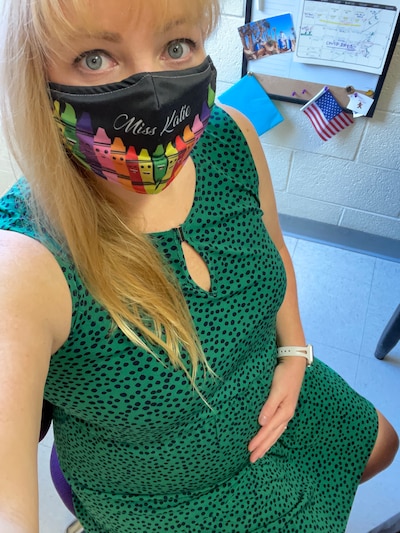
One of the only problems Kathryn Vaughn encountered from wearing a mask as an elementary art teacher was that her students couldn’t always hear her. The mask muffled her voice.
But early on in the pandemic, she had an exchange on Twitter with Rosanne Cash, Johnny Cash’s daughter. The two started talking, and Cash ended up sending Vaughn supplies for her classroom, as well as a microphone and headset. Problem solved.
“I look like Britney Spears when I’m teaching, which is amazing,” Vaughn said.
Over the last year, the bigger issue for Vaughn has been the mask policy in her school district in Covington, Tennessee. At the start of the school year last August, all students and staff were required to wear masks. A few months later, they dropped the mandate. By December, cases were climbing rapidly, and it was reinstated. Then two weeks before the school year ended, the district revoked the mask mandate again.
Vaughn, who was vaccinated in January, said she wishes they would have kept the mask mandate the whole year. It would have made her feel safer, and it also would have given some uniformity to the rules for her students. As soon as the mandate was lifted, almost no one wore masks voluntarily in the school, she said.
“The kids were telling other kids, ‘you don’t have to wear that anymore, we’re not doing that,’” Vaughn said. “And I was like, ‘well, you could do that if you want to protect yourself because you’re not vaccinated. Let’s not judge other people’s choices.’”
The day after she received her first vaccine dose, Vaughn found out she was pregnant. She still wears a mask as a precaution and plans to do so at the start of the next school, even though she doesn’t expect the district to go back to requiring it.
“I don’t ever want to teach through a pandemic again, but my major thing was I knew I could keep myself as safe as possible by keeping my mask on and keeping my window open and ventilating my room with air,” she said.
Christina Sarraino
Lorain High School in Lorain, Ohio
Teaches students with social and emotional challenges
Before the pandemic, Christina Sarraino was used to running up and down three flights of stairs at Lorain High School several times a day. But what was once moderate exercise between classes became almost “suffocating” in a mask, she said.
“(The mask) really does make a difference, but I don’t want to take it off and make a big deal about it because then they do,” she said, referring to her students.
Sarraino is an intervention specialist who teaches high schoolers with social and emotional challenges. Some of them have intellectual disabilities or autism, too. For Sarraino, one of the hardest parts about teaching in-person this year was enforcing mask use.
“We did have a couple meltdowns because of the face masks to be quite honest,” she said. “We had kids with sensory issues, and the mask irritates that. I would try to explain why we’re doing it: to protect you, to protect your family, to protect our families. Explaining all of that and trying to get to academics and their social and emotional needs, with everything going on, was difficult.”
Sarraino was diligent about keeping her own mask on at all times, but she found she had to make compromises with her students, allowing them breaks without the masks to eat snacks and drink water as long as they were at least six feet apart.
Her district has not made a decision about whether they will require masks next year. In the meantime, Sarraino is encouraging her students to get vaccinated if they are eligible and hoping that the possibility of a mask-free year next year will be an incentive.
“I teach science generally,” Sarraino said, “and we try our best through science to really dispel any of the conspiracy theories that we hear — and we hear quite a few — to try to get the kids to not be afraid of the vaccinations.”
Sharity Keith
Boca Ciega High School, St. Petersburg, Florida
11th and 12th grade teacher
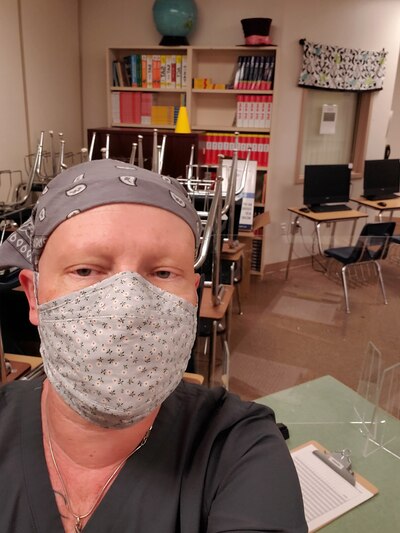
After nearly 20 years of teaching, Sharity Keith planned to make a career change last year. But when the pandemic closed everything down, she decided to stay for one more year, teaching reading to 11th and 12th graders who failed Florida’s state assessment and needed to catch up.
Since the beginning of the school year, Keith has simultaneously taught students remotely on video and in-person in the classroom, which essentially doubled her work — to 70 and 80 hours a week at times. Talking so much through a mask every day left her voice permanently hoarse, she said. In the beginning, she was so fearful of catching COVID that she wouldn’t take her mask off at all at school, meaning she didn’t eat or drink water until she got home. Keith said she loves teaching and may come back to it, but this year left her exhausted.
“I wouldn’t say the pandemic is why I’m leaving,” Keith said, “but I think the pandemic has highlighted for me what I already knew, which is that teaching is simply not valued by the community.”
Boca Ciega High School in St. Petersburg, where Keith teaches, required students and staff to wear masks all year. Keith was grateful for that, but the masks added another layer of challenges. Many of her students are English language learners, and the masks made it harder for them to understand each other. Some of them eventually stopped showing up, she said.
Keith also teaches phonics to some students, and she found it difficult to enunciate through her mask and exaggerate the sounds: mmmaaa, bbbbaaa, pppaaa. “For a lot of my kids, it was like, ‘this is embarrassing,’” Keith said. “‘Here I am at the age that I am and this is what we’re doing.’”
Keith did her best to keep up their spirits by making jokes and celebrating when they passed their tests, but motivating them was a constant challenge. Caring for herself was, too. By the end of the year, she was comfortable enough to take her mask off to eat a little bit at school, but her voice is still not back to normal, despite regularly using throat spray to soothe it.
“I don’t think I’m going to talk at all this summer,” she joked.
Yvette Andino
Bilingual school counselor at two public schools in Queens, NY
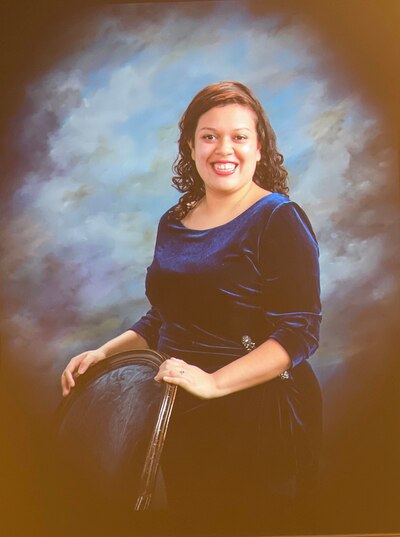
One of the biggest parts of Yvette Andino’s job as a school counselor in Queens is showing kids what emotions look like as facial expressions. This last year, Andino worked with some students virtually and others in person, where masks were mandatory.
“There are some emotions I couldn’t show with my mask, like anger and sadness or the surprised feeling or shocked feeling,” Andino said. “You kind of form your mouth like an ‘O,’ like ‘oh, shoot’ or ‘oh, man.’ That was really hard for them to learn.”
Andino works primarily with elementary students who speak English and Spanish. Some of them are on the autism spectrum or have speech impairments. For these students, she had to get creative. Working with them in-person, Andino showed videos or drew pictures. If that failed, she stood 12 feet away from them in her office and briefly lowered her mask to show her own facial expression. She tried using a clear face shield in the beginning, but they gave her tension headaches and weren’t as effective as masks at stopping the spread of COVID.
For many of Andino’s students, it took three times as long as it normally would for them to learn how to recognize and understand certain emotions, but they eventually got there, she said.
In New York City public schools, face masks will still be required at the beginning of the next school year, officials have said, but guidelines are changing all the time. If given the choice to wear a mask, Andino is not sure what she would do.
“I would love to live in a world without masks,” she said, “but if it is for safety and it’s an option, I think I would ask the students. Some will straight out tell me they prefer masks or they prefer I show them my facial expression. They’ll tell you if they’re comfortable or not.”


